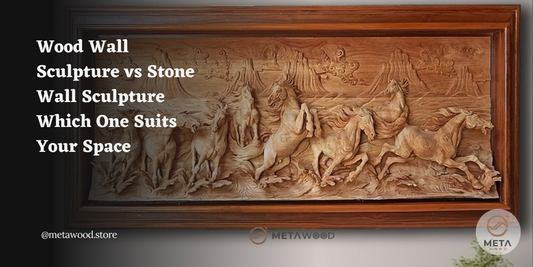Understanding Wood Selection for Relief Carving
When it comes to relief carving, selecting the right wood is crucial. The characteristics of the wood directly impact carving techniques, durability, and the final aesthetic of the artwork. At MetaWood, we prioritize the use of high-quality wood to ensure exceptional results in our hand-carved creations.
- Teak:
Originating from Southeast Asia, teak wood has a rich history and is highly regarded for its durability and exceptional carving properties. It has been used for centuries in relief carving due to its natural resistance to decay, making it suitable for both indoor and outdoor applications. Teak's beautiful grain patterns, ranging from straight lines to wavy or interlocked designs, add depth and visual interest to relief carvings. - Mahogany:
Native to tropical regions such as Central and South America, mahogany wood has a long-established reputation for its beauty and versatility in relief carving. It has been prized for centuries for its reddish-brown color, fine texture, and natural luster. Mahogany's interlocking grain allows for clean and precise carving, making it a preferred choice for intricate relief designs - Walnut:
Walnut wood derives from various species found primarily in North America and Europe. It has a distinguished dark brown color and a prominent grain pattern that enhances the visual appeal of relief carvings. With its medium hardness, walnut is a versatile wood that allows for both delicate detailing and bold, deep relief carving. It has been used for centuries in furniture making and decorative arts due to its rich, warm tones. - Maple:
Maple wood comes from trees found across North America, Europe, and Asia. Its light color and fine texture make it a popular choice for relief carving. Maple has a straight grain pattern with occasional bird's-eye or curly figuring, adding character to carved designs. Its close and even grain allows for crisp, intricate detailing in relief carvings, making it a preferred wood type for achieving fine, delicate artwork. - Oak:
Oak wood has a rich history in woodworking and relief carving, with species found in many parts of the world. Known for its strength and durability, oak possesses a distinctive grain pattern that adds a unique character to relief carvings. The pronounced rays and open pores in oak create visually appealing effects when carved. It is a favored wood for both intricate and bold relief carving designs, showcasing the timeless beauty of this classic material.
Choosing the Right Wood for Your Relief Carving Project
Selecting the appropriate wood type for your relief carving project requires careful consideration. Factors such as project complexity, desired aesthetic, and personal preferences should guide your decision. Consider the wood's hardness, grain patterns, workability, and availability to ensure it aligns with your carving needs




